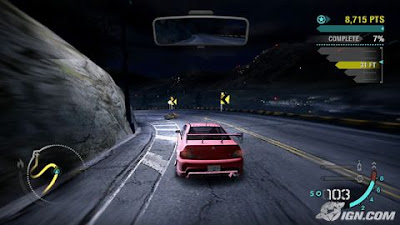20 December 2006
Leadership - and - War
No wonder lots of country doesn't like US. US involve too many wars.. wars against other country
Imperial - History
History - of - Religion
17 December 2006
Need for Speed Carbon

You and your crew must race in an all-out war for the city, risking everything to take over your rivals' neighborhoods one block at a time. As the police turn up the heat, the battle ultimately shifts to Carbon Canyon, where territories and reputations can be lost on every perilous curve. Need for Speed Carbon delivers the next generation of customization giving you the power to design and tweak your crew's cars in every way using the ground-breaking new Autosculpt technology. Represent your car class, your crew, and your turf in Need for Speed Carbon, the next revolution in racing games.
I rate NFS Carbon 95%, best car racer games. Actually, i do want NFS Carbon has element of car hit & crash like "Burn out revenge". Maybe the developer will add this element at the next version of NFS.
New Project Interior Design

New project of Interior Design for Wedding Planner & SPA service. This new project for 'Nabies' a company that manage wedding planner, ceremony, dais, etc. The pic above is one of 5 plan proposal. The challenger of this project is i need to arrange many rooms in a small work area.
If you have any ideas, please leave a comment please!!!
14 December 2006
Gear of War XBox 360
Gears Of War
In the simplest of words: Oh. My. God. You can open the package and you expect somewhat of a standard FPS, with better than average graphics. But Gears Of War may be the bloodier and better incarnation of both Halo 1 or 2, and HalfLife 2.
With graphics powered by the Unreal 3 engine, the amount of spit and polish on this product is immense. The refinement of both the control system, the camera movement, the interaction with the environments, other players, online co-op of the standard single-player campaign, the quality of the AI, and the new puzzles and challenges brought on by your abilities makes this game, the de facto standard of what to expect for “next-generation gaming”.
- First off, the graphics really are as good as that screen capture above.
- The game play is awesome, giving you the ability to run behind objects for cover from the onslaught of enemies. Gaining incremental runs towards a target, while running is impressive, but incorporating this into various missions (pushing bullet-ridden cars along a street in the middle of a firefight to use for cover) and boss fights (running for your life).
- The new user tutorials are part of the mission as in games like Halo, but some parts of the mission are multipath. In other words, you come to a fork in the road and you choose either route. In the opening, this is cleverly handed to you as either go straight to combat, or go straight to training to “workout the kinks”.
- Weapons are fun, with the added gore-magnet of a chainsaw attached to one of your rifles as a bayonet. So should you be equipped with this weapon and decide to use it when a foolish alien comes in for close-quarters combat. You fire it up, saw them in half, and enjoy the blood that splatters and drips on the lens of the camera.
- Yes, there are vehicles, much like in Halo.
There’s more but I could illustrate more by pointing to this stunning trailer for the game. It is all done in-game with no pre-rendered 3D graphics and the haunting music is an unusual but glorious piece to overdub the movie to. The whole thing shows as poetry-in-motion and that’s exactly what Gears Of War is!
UPDATE:
So I’ve finished the game and am still addicted to the running camera movements and the online coop play. The game is shorter than I anticipated, but still a quality buy. In addition *SIGH* it falls a little short in storytelling with a full-bodied storyline (a negative since I have compared it to Halo 1). I’m replaying it on the “Insane” difficulty level which is only do-able if you tackle the game with a quality human partner, online or in the same room. I’m not sure if I maintain my original statement of the game being as much of a genre-defining icon as Halo, but it is certainly the new standard of FPS gaming on the next-gen of consoles. Without question, don’t miss out on it. - SWL
This blog taken from: http://www.secretweaponlabs.com
/words/2006/11/08/
you-cant-resist-give-in-to-the-xbox-360/
13 December 2006
Microsoft Expression Studio 2007
 The Expression PM and Designer Team, 2006
The Expression PM and Designer Team, 2006Expression Blend is a tool to produce user experiences for the Windows Presentation Framework. It is targeted primarily at designers, not developers.
The Expression Studio is a comprehensive set of tools built by and for creative professionals for the purpose of augmenting the creative process and helping integrate designers and developers into a smooth and efficient workflow. Expression Studio comprises Expression Web for creating standards-based Web sites; Expression Blend for designing rich interactive experiences for Windows®; Expression Design for the design of visual elements for Web and Windows experiences and Expression Media, which provides digital asset management and unifies team workflow across the suite. Expression Web is shipping now, and the full Expression Studio is planned for delivery in the second quarter of 2007.
The rest of this article will focus on the user experience provided by one of the products in the studio–Expression Blend–and how it helps designers and developers build incredible experiences for Windows and other platforms which use a user interface framework we call the Windows Presentation Foundation or simply WPF.
In early 2006, we decided to make significant changes to the user experience for Expression Blend, then known as Expression Interactive Designer. We wanted the experience to be more designer-friendly, easier to use, and, last but certainly not least, we wanted a new fresh look.
Let us discuss a few of the areas of the user interface that we gave particular focus on in the re-design.
Focus on the Art Board
We wanted designers to be able to focus as much as possible on the art board. We wanted to have as little UI as possible on the screen, or at least enable designers to work with a minimized UI if they so chose. We therefore tried to identify the UI elements that are really required for typical tasks, and to give appropriate priorities. Also, we provided for a mechanism that lets almost the entire UI slide away with a single keystroke, leaving the art board with the basic toolbox and popup property inspectors that come into view and vanish on demand.
Blend solves these issues with:
- Timeline on demand. In the old UI, the scene tree and the timeline are one entity. Because the scene tree is really quite important, the timeline is always visible, taking up a lot of screen space even if no animation is being created. In the new UI, the timeline is not visible by default, but comes into view on demand–there always is a small slide-out timeline, and for more complex animations, a separate workspace is provided.
- Multiple workspaces. The new UI provides two workspaces–design and animation. In the design workspace, we focus on the scene tree, properties, and resources, which are all the things commonly needed when creating static designs. You can animate in the design workspace with an on-demand timeline, but in design mode the timeline is narrow, appropriate for transitions with a few keyframes. In the animation workspace, the timeline takes up a good part of your screen width, thus allowing for much better control over animations with many keyframes.
- Single key shortcut to hide the UI. By pressing the Tab key, the UI can be hidden almost entirely, leaving just the toolbox and property editors. Furthermore, the property editors are reduced to pop-up category icons, giving quick and easy access to each property category without taking up the screen space the full-size editor requires.
Property Editing

Getting colors, fonts, strokes, margins and many other properties just right is an essential part of the authoring process. A lot of the user experience in authoring tools of all kinds revolves around property editing. Expression Blend is no exception.
In the new design, we wanted a property editing experience where all properties available for something selected on the art board could be found in one place. We also wanted a rich, interactive editing experience with immediate, continuous feedback and easy access to all of the special WPF property functions such as resources and data binding.
The new property inspector does just that. In a header section, it identifies what is actually selected on the art board, showing name and type of the selection. As WPF controls can have quite a lot of properties, it allows for property filtering–type a few letters in the search box, and only properties with names that contain the letters typed will be displayed.
Below the header, all properties are distributed over a number of categories that can be expanded and collapsed as required. Each category contains the most important properties that belong to that category: less frequently used ones are out of sight, but just a mouse click away in slide-outs at the bottom of the category.
There are many rich property editors in the property inspector. Even simple numeric fields are really interactive sliders–you can just drag over the fields to adjust values, using the screen as a virtual slider area.
Tools and Assets
In Expression Blend, there are many of the tools you would expect in a typical vector graphics application: selection, drawing tools such as pen, freehand or shapes, viewing controls, et cetera. But because WPF also provides a large set of pre-made controls, the ability to extend this set with custom controls and styles, and a powerful mechanism to layout vector graphics and controls in a UI, a normal toolbar wouldn't quite do. The Expression Blend toolbar combines the functions of a traditional toolbar and an asset library in one.
The new toolbar provides the basic selection tools and access to the most important standard controls via normal tool icons with flyouts. When a control is selected from the toolbar, it acts like a drawing tool–or in other words, you can just draw the control on the art board.
There also is an asset tool that gives quick access to a whole lot more: Standard controls, custom controls, user-created new styles and templates, media that is part of the project, and more. You can use assets as drawing tools or via drag-and-drop, and you get searching and other useful functions.
Resources
Resources are a powerful mechanism in WPF. They allow designers to define a set of standard items (relatively simple things such as colors, brushes, sizes, or typography settings, but also complex items such as styles and templates for controls) and then use these defined items rather than literal values all across the project. The benefit is that changing the resource will change all places where the resource is used–a great way to guarantee consistency of a design. In Blend there is a dedicated panel for resource management. You can browse, organize, and edit resources right there, and of course use it to select and apply resources to things on the artboard.
New Look

With Blend, we wanted to dramatically enhance the visual appearance of the interface. We really had two conflicting goals for that: On one hand, we wanted a UI that could be as unobtrusive as possible, a UI that could fade into the background to let the artist focus on the art board, a design that could blend into the background. On the other hand, we wanted a UI that had character, would be immediately recognizable as the Expression UI, allow us to build brand recognition, and be beautiful and elegant. Beyond that, we also wanted to move away from 3D-ish, gel-like looks, as we felt they had become quite overused. And, to add further constraints, in a visual design system UI, there is little scope for colors beyond shades of grey.
A user's first response to software is an emotional one, where its interface is not only judged by how it looks and functions, but by how it feels. Is it inspiring or annoying; cheap or professional? As designers, we understand how sensitive and finicky designers can be about their visual and interactive environments.
The design opportunity for Expression was quite exciting, as we had to create a look not only for Blend, but for an entire suite of professional tools that required a unified user interface. The challenge was defining visual commonality within the wide range of applications in the suite.
Since we wanted to do something entirely different for the interface, we turned to such diverse inspirational sources as stealth fighter jets or 1980s radio design. We wanted to find a look that moved away from current trends, yet still felt contemporary, was useful, and targeted to our audience.
In the low-light settings that many designers prefer, a bright or near-white interface can be visually distracting. Therefore, we chose a darker palette for the default interface that is better suited to the way the audience uses software as well as to their work environment itself. In addition, we restrained the use of color to minimize the chance of a design project being influenced by colors used in the UI itself.
After many design explorations and iterations, we have implemented a design that gives the Expression products a distinct, easy-to-use interface. And we are already playing with many ideas to further streamline the interface and to make it more elegant and forward-thinking in versions to come.
02 December 2006
Next-Gen Console: You Decide The Best
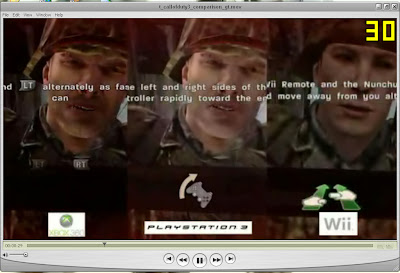 In XBox360, you can see the German army face is full with dust & dirt (are you not taking shower for a week?)
In XBox360, you can see the German army face is full with dust & dirt (are you not taking shower for a week?)In PS3, man!!! are you taking bath 5 minutes ago?? You look fresh...
In Wii, man!!! you look so young?? How old are you??
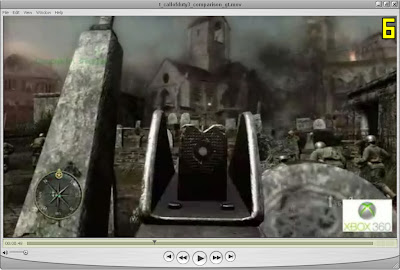 Detail environment & blur environment when you focus on the gun aiming
Detail environment & blur environment when you focus on the gun aiming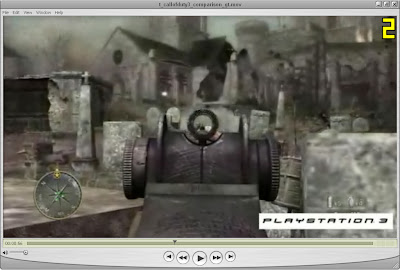 Just blur environment when you focus on the gun aiming
Just blur environment when you focus on the gun aiming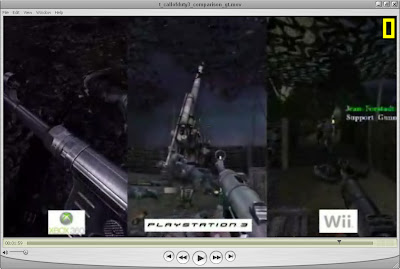 In Xobx360, detail gun shading & looks like metal
In Xobx360, detail gun shading & looks like metalIn PS3, not too detail & not too metal
In Wii, No comment!!!
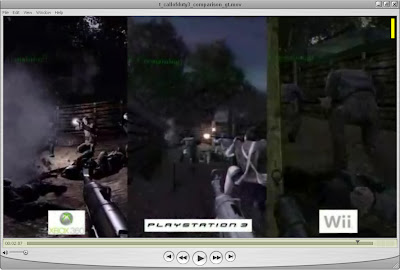 In Xobx360, detail gun shading & looks like metal
In Xobx360, detail gun shading & looks like metalIn PS3, not too detail & not too metal
In Wii, No comment!!!
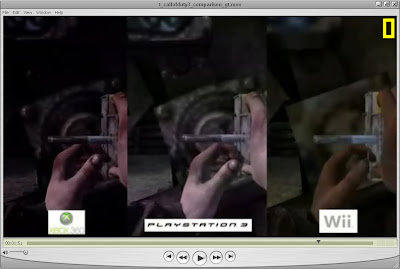 In Xbox360, dust & dirt are display cleary at the hand, bomb and screwnut
In Xbox360, dust & dirt are display cleary at the hand, bomb and screwnutIn PS3, dust & dirt are display not too cleary at the hand, bomb and screwnut
In Wii, no comment
29 November 2006
Windows Live Technology
 As the real and virtual world merge, people expect their online, mobile, and PC experiences to seamlessly integrate. Windows Live mission is to harness the power of the Web in a way that lets people easily find the information and pursue the interests that deepen their relationships -- and enrich their lives.
As the real and virtual world merge, people expect their online, mobile, and PC experiences to seamlessly integrate. Windows Live mission is to harness the power of the Web in a way that lets people easily find the information and pursue the interests that deepen their relationships -- and enrich their lives. Windows Live™, is a new set of personal Internet services and software that are designed to bring together in one place all the relationships, information and interests people care about most, with enhanced safety and security features across their PC, devices and the Web.
Tools & Services of real/virtual integeration
1. Find and Discover Information
Live.com, customizable home page for Windows Live, helps users quickly customize their home page, preview content, create multiple pages based on their interests, and add their favorite content from millions of information sources and RSS feeds.
Live.com will also be a platform for third-party developers to build and deliver customized services, called “gadgets,” to customers. Live.com is available in beta form at http://www.live.com, and more information can be found at http://ideas.live.com.
Windows Live™ Search. With expected delivery in 2006, Windows Live Search will deliver powerful and personal search services that help consumers find what they are looking for on the Web, their desktop, their mobile device or in their local geographic area, such as instant answers, documents, pictures, multimedia content, local information and immersive maps. Windows Live Search will be a core element of the overall Windows Live experience, powering compelling scenarios across the Windows Live services.
Windows Live™ Toolbar offers people the ability to search from any Web page using Windows Live Search while helping them easily save, organize and share the information that they find online. Advanced protection against phishing and pop-up blocking also help people browse more safely while they search. Additional features of the beta include RSS detection and automatic aggregation to a person’s personalized Live.com home page, capability for effortless customization so people can choose and arrange only the buttons they want, and tabbed browsing for quicker Web surfing. The Windows Live Toolbar includes technology from Onfolio Inc., which enables customers to save, collect and share any part or the full Web page of the information they discover while searching the Web.
2. Enhance and Deepen Relationships
Windows Live will provide users with a set of new and more meaningful ways to communicate and share with the people they care about:
Windows Live™ Mail. Windows Live Mail is Microsoft’s new, global Web mail service, built from the ground up to be faster, safer and simpler while delivering powerful new customer scenarios. Currently in limited beta testing, Windows Live Mail will continue to evolve through customer feedback, scaling to more customers over the coming months. MSN® Hotmail® customers will be able to use Windows Live Mail with their existing Hotmail ID. People can sign up to join the Windows Live Mail beta at http://ideas.live.com.
Windows Live™ Messenger. Windows Live Messenger builds on MSN Messenger to help people develop even deeper connections with the people they care about through a variety of experiences — from communication to sharing. Future enhancements will enable people to place PC-based calling through Windows Live Messenger (this feature will be provided through third-party commercial relationships). Windows Live Messenger will also allow users to more easily share files such as their personal pictures and documents with their contacts. People can learn more about the Windows Live Messenger beta in the coming months at http://ideas.live.com.
Windows Live™ Favorites is a service that enables individuals to access their Microsoft Internet Explorer and MSN Explorer favorites from any PC that’s online. The service is currently in beta form at http://ideas.live.com.
Windows Live for mobile devices. People do not always have easy access to a PC, but that doesn’t mean they won’t be able to access their important communications or information via Windows Live services. Microsoft is working to ensure that Windows Live services including Windows Live Mail and Windows Live Messenger and more are available through mobile devices — from rich experiences on Microsoft Windows Mobile®-powered devices to basic Internet-enabled phones.
3. Explore and Find New Interests
Windows Live will deliver new ways for customers to discover and explore:
Social Networking. Social Networking features for Windows Live will be based on the people whom customers know rather than strangers who may visit their blog or Web site. Social Networking in Windows Live will be centered on a customer’s unified contact list, enabling the user to find and connect with people who have similar interests, but may be new to his or her social circle. Customers will be able to choose and control who has access to discover and connect with them.
Windows Live Spaces. Microsoft will continue to invest in services that help people express themselves, and find, connect and nurture deeper relationships with others around the world. MSN Spaces will transition to Windows Live Spaces as Microsoft adds new features to the service next year.
4. Protection and Performance
Windows Live will offer consumers a set of tools and services to help keep their computing experience safer:
Windows Live™ Safety Center. Helping protect customers is important to Microsoft. The Windows Live Safety Center is a free, Web-based, on-demand service that will enable customers to scan their PC for viruses and clean their PC, as well as perform other tasks to help protect their PC and Windows Live services. Windows Live Safety Center is currently in beta form and can be accessed through http://ideas.live.com.
Windows OneCare™ Live. Customers will be able to take the health of their PC to the next level with Windows OneCare Live, a robust subscription service that not only helps protect your PC from viruses and spyware, but also helps ensure that it continues to run well by keeping it up to date and helping make sure the system is maintained regularly. Windows OneCare Live will also manage backups to help give customers peace of mind that they won’t lose the information, photos, music, documents or other files on their PC that are important to them. Windows OneCare Live is currently in managed beta testing, and people can nominate themselves participate at http://ideas.live.com.
Integrated protection. Beyond the Windows Live Safety Center and Windows OneCare Live, Microsoft is also making many more investments to help protect customers as they use Windows Live services, such as the Microsoft Phishing Filter, currently available for the MSN Search Toolbar and which will be available in the future for Windows Live Search customers, Smartscreen spam and phishing filtering for Windows Live Mail, and much more.
Microsoft Office 2007 Screenshort
 Colorful Chart
Colorful Chart Shape Maker
Shape Maker Word Editor
Word Editor Choose Template
Choose TemplateOffice 2007: New Visuals
The Office branding is consistently and seamlessly interwoven through the 2007 Microsoft Office Suite appearing in the new packaging, wizard graphics, help-about dialogs and splash screens.
The 2007 Microsoft Office system has a new intuitive user interface. The Office 2007 user experience is designed around achieving results rather than trying to find commands.
The ribbon takes the best of menus/toolbars and combines them into one place. The new contextual tabs quickly make tools available for completing a particular task.
New AcerPower PC Model 1000 & 2000
 New AcerPower PC model 1000 & 2000 been launched today in Malaysia. This new invention with special case and style simply same like SONY PLAYSTATION 2 casing... The model is 10 times smaller then other PCs but have powerfull specifications and saving energy cost.
New AcerPower PC model 1000 & 2000 been launched today in Malaysia. This new invention with special case and style simply same like SONY PLAYSTATION 2 casing... The model is 10 times smaller then other PCs but have powerfull specifications and saving energy cost.AcerPower package including:
- LCD monitor
- Processor AMD Athlon 64 X2, Athlon 64 & Sempron.
- (or you can choose Intel DuoCore)
- Video Graphic:Nvidia GeForce 6150
- Motherboard that provided chip set 946GZ express, supported by Intel GMA 3000 graphic technology
- Hard Disk: 400 GB SATA 3 GB
for more information visit to www.acer.com.my
Market price is RM2,088 and above.
PS: I think this model will be sell to the public about RM2,599 to RM2,999.
27 November 2006
Database Tool "FileMaker Pro 8.5"
 FileMaker now became a popular database tool among developers, looks like developers take a new step using this tool then Microsoft Access for developing small & medium application. I also used FileMaker Pro 8.5 to developed system for my own IT Company. Currently my company working on Project “ZMIS” Zimuda Management Information System. Any update information will be announced later. Here a few info about FileMaker Pro 8.5
FileMaker now became a popular database tool among developers, looks like developers take a new step using this tool then Microsoft Access for developing small & medium application. I also used FileMaker Pro 8.5 to developed system for my own IT Company. Currently my company working on Project “ZMIS” Zimuda Management Information System. Any update information will be announced later. Here a few info about FileMaker Pro 8.5  FileMaker Pro 8.5 Advanced includes all the features of FileMaker Pro 8.5 plus a suite of advanced development and customization tools to help you design and develop more powerful, more customized database solutions – faster and easier than ever before!
FileMaker Pro 8.5 Advanced includes all the features of FileMaker Pro 8.5 plus a suite of advanced development and customization tools to help you design and develop more powerful, more customized database solutions – faster and easier than ever before!Design and develop databases faster and easier
Customize your database even more by adding your own menus and menu items using the Custom Menu feature of FileMaker Pro 8.5 Advanced. Plus, you can add Tooltips to layout objects to make your layouts more intuitive. Even create standalone, runtime applications that include the new FileMaker Web Viewer.
Debug and troubleshoot more efficiently
FileMaker Pro 8.5 Advanced includes essential debugging and reporting tools that help you build stable, reliable solutions more efficiently. It’s easier than ever to pinpoint problem areas by reviewing scripts step-by-step in the Script Debugger. You can monitor fields, variables, expressions, and even test calculation formulas with the Data Viewer, as well as temporarily disable script steps to test portions of your scripts.
Modify and maintain with ease
Once you’ve designed and deployed your database, the FileMaker Pro 8.5 Advanced database reporting and optimization features will help you update solutions more easily and keep them running at peak performance. Update databases faster by importing multiple tables or by using copy/paste to move fields, tables, scripts, and script steps. Get comprehensive information on database schema and options, like fields, web viewers, layouts, Custom Menus, and more with the Database Design Report. Plus, the FileMaker Maintenance Tools will ensure you’re getting maximum performance from your solutionsFor more detail please visit FileMaker Official Website
20 November 2006
Xbox 360 HD DVD Player
Lights, camera, action! Xbox 360 HD DVD Player Australian launch details revealed
Major movie studios back HD DVD with Universal Pictures leading the charge
Xbox transforms the Australian home entertainment landscape by giving consumers a clear choice early next year with the release of the Xbox 360™ HD DVD Player. Launching at $249.95 in Australia, the Xbox 360 HD DVD Player will be the most affordable high definition movie player currently on the market in Australia*.
Xbox 360 is the only video game console that lets consumers choose when to upgrade to high definition movie content; when you’re ready you can simply plug in the Xbox 360 HD DVD Player to your console to create the ultimate home theatre experience. The Xbox 360 HD DVD Player lets you watch visually amazing high definition movies, and the HD DVD format up-scales your existing collection to enhance the picture quality.

The major movie studios and local film distributors are already lining up in support of HD DVD, including Universal Pictures. The Australian release of the Xbox 360 HD DVD Player will come complete with the Universal Pictures blockbuster film “Peter Jackson’s King Kong” on HD DVD. Other HD DVD titles available early next year will include “Serenity”, “Jarhead”, and “The Bourne Supremacy”.
David McLean, Regional Director Xbox Australia and New Zealand, says, “Xbox 360 is already the best value next generation video game console. It’s now rapidly becoming the heart of the home entertainment system. We’re offering consumers the choice of jumping into the next generation of DVD technology, and they can do so for less than the price of competing products, including stand-alone high definition movie players and other games consoles.”
Microsoft chose HD DVD as the format for high definition content on Xbox 360 because it offers a compelling consumer experience and delivers superior picture quality and interactive features. Globally, HD DVD is streaking ahead by not only selling in greater quantities and scoring great reviews but also in its vast array of available content, now and in the future.
Joanna White, Marketing Director from Universal Pictures says, “Universal is very excited to support the Xbox 360 HD DVD Player and is absolutely committed to a successful long term relationship with Xbox and the HD DVD format. The future of high definition home theatre is HD DVD and ‘Peter Jackson’s King Kong’ is the perfect demonstration of the format’s exceptional capabilities.”

The Xbox 360 HD DVD Player offers stunning video and immersive surround-sound audio with up to six times higher resolution than DVD. HD DVD allows for innovative, interactive content enabling PIP (picture-in-picture) commentary, scene selection and menu access, all while the movie is playing.
As part of the recent Xbox Live® update, all Xbox 360 consoles now have the ability to output native resolution 1080p movies and games. Early adopters who have displays that support 1080p over VGA and component can now experience the benefit of a crisper, cleaner picture.
Unpacking the PlayStation
November 15, 2006 by: Chris Remo
 PlayStation 3 is a very shiny console. That's really the first thing that strikes you as you lift it out of its handle-equipped packaging and remove the protective wrapping. That's exactly what I just did with our final retail model of the PlayStation 3, which just came in. Here, I'll share initial impressions of the system, from the physical hardware to its software interface.
PlayStation 3 is a very shiny console. That's really the first thing that strikes you as you lift it out of its handle-equipped packaging and remove the protective wrapping. That's exactly what I just did with our final retail model of the PlayStation 3, which just came in. Here, I'll share initial impressions of the system, from the physical hardware to its software interface. As you are most likely aware, PS3 comes in two versions, a $599 60GB hard drive-equipped version, and a $499 20GB version. Functionally, the two systems are nearly identical, particularly since the 20GB model has been outfitted with initially unexpected HDMI capability. For your extra hundred clams, you'll snag built-in wi-fi, support for multiple memory card formats including SD, CompactFlash, and Memory Stick, and of course 40GB more hard drive space.
The 60GB hard drive model, which we received, also has a stripe of silver trim that goes to enhance the system's shininess. It is clear that in this console generation, Sony is shooting for the upscale look. Nintendo's machine aims to be the accessible everyman console, Microsoft's strives to be hip and youthful, and Sony's is imposing and exclusive. This aesthetic is borne out by the machine's upper-end price tag, physical girth, and cornucopia of high-tech features: 1080p output, HDMI, Blu-ray, support for multiple storage media formats, wi-fi, easily upgradeable hard drive, and so on.
Speaking of that last bit, the upgradeable hard drive, it does indeed seem that it is quite easy. Some internet users have expressed concern that replacing the hard drive may be a procedure that requires opening the machine and voiding the warranty, but that is not the case. There is a clearly labeled port on one side of the machine that comes off easily, then a single screw that must be removed to allow the hard drive to slide free. There is a mounting bracket on the included hard drive to be affixed to the new hard drive, then it simply slides right back in. Both PS3 models will accept any standard 2.5" internal serial ATA drive.
Setting up the PS3
PlayStation 3, as a broadly high-definition device, supports several types of video output cables: composite, component, s-video, and HDMI. Rather annoyingly (and surprisingly, given Sony's heavy focus on HDTV with PS3), the system only includes the 480i-supporting composite cables. On the upside, PlayStation and PlayStation 2 video output cables of any type work just fine with PlayStation 3, so if you've got component cables left over from PS2, you're all set. As a courtesy, Sony also supplied us with an HDMI cable;  the system has a standard HDMI port with no proprietary connector, and this is what we used to get our system up.
the system has a standard HDMI port with no proprietary connector, and this is what we used to get our system up.
After plugging everything in with your cables of choice and turning on the console, you'll be presented with a prompt to plug in the included wireless Sixaxis controller with a USB cable. This is simply a standard USB-to-mini-USB cord that comes with the system and connects the controller to the console. When connected, it both recharges the controller's internal battery and transmits control data. One niggle is that the included USB cord is quite short. In general, the cable will only be used when the controller is charging, so it shouldn't be too much of an issue, but for the initial charging period (during which you're certainly going to want to be playing your brand new PS3) it's a bit inconvenient.
There's a standard progression of basic console settings--time and date, video resolution options, and so on--and at the end you are asked to input your name. As on the PSP, Sony has opted for a cell-phone-like input system with eleven buttons, each of which contains several letters that can be cycled through with quick repeated tapping of the X button. If you've ever used a phone to send a text message, it's very easy to get the hang of. You can also plug in a USB keyboard to expedite things.
Getting into the main menu
After inputting your name, the machine loads up its main dashboard, accompanied by a pleasant orchestra crescendo and satin-like rolling backdrop that serve to continue with the system's deliberately elegant atmosphere. Functionally, the dashboard is very much like the PSP's cross media bar; numerous categories are arrayed horizontally, with some of them containing nested vertical menus for additional options. The top-level categories are as follows:
Users: Allows you to create additional user profiles or switch between them.
Settings: Contains a vast number of system configuration options, as well as a button to automatically download the latest official software update. When I selected that option, I began downloading the current firmware version. Surprisingly, it took about 35 minutes to download and install the update.
Photo: Allows you to browse photos from a storage device, in which you can zoom and pan on specific images. There's also an included photo album application that will arrange your photos into an animated slide show that renders the pictures as if they were actual hard copy photographs being lightly tossed onto a table. The controller can be used to change the scrolling speed or direction of the slideshow. It's not a crucial feature but it is actually rather well done and pleasant to watch.
 Music: Here you can play music from a storage device or optical disc such as a CD. If you put in a CD, the system will automatically detect album information. The audio player itself is basically what you'd expect, with standard playback functions and the option to turn on a basic visualization feature that scrolls through a few different colorful patterns. You can also import music tracks to the hard drive; through the Settings menu, you can set the system to encode in AAC, MP3, or ATRAC formats at a variety of bitrates. After ripping it, you can choose to sort or group tracks by artist or album name. Unfortunately, it doesn't seem that you are able to leave the music playing while you do other things on the dashboard. You can also play music in those same formats from a flash memory card; note that to get the system to detect the files, you may have to press triangle with the flash card highlighted and select "Display All." This eluded us for several minutes. From there you can play the media or copy it to the hard drive.
Music: Here you can play music from a storage device or optical disc such as a CD. If you put in a CD, the system will automatically detect album information. The audio player itself is basically what you'd expect, with standard playback functions and the option to turn on a basic visualization feature that scrolls through a few different colorful patterns. You can also import music tracks to the hard drive; through the Settings menu, you can set the system to encode in AAC, MP3, or ATRAC formats at a variety of bitrates. After ripping it, you can choose to sort or group tracks by artist or album name. Unfortunately, it doesn't seem that you are able to leave the music playing while you do other things on the dashboard. You can also play music in those same formats from a flash memory card; note that to get the system to detect the files, you may have to press triangle with the flash card highlighted and select "Display All." This eluded us for several minutes. From there you can play the media or copy it to the hard drive.
Video: Here you can play videos from a storage device or optical disc such as a DVD or Blu-ray Disc. The manual specifies that only MPEG-4 video files are playable from flash memory cards. We attempted to play MPEG-4 as well as DivX, MPEG, QuickTime, and Windows Media videos, and succeeded in getting both MPEG and MPEG-4 to play. As with music, you may have to press the triangle button and select "Display All" on the memory card to be able to browse through your videos. As far as Blu-ray discs, I can't offer any deep critical opinion, but they look great running in 720p and undoubtedly look even better in 1080p. Audio is mixed in uncompressed 5.1 PCM, which is sure to be a plus for audiophiles. That's all I'm really going to say about Blu-ray. (Come on, this is a gaming website!)
Game: Highlighting the Game option will replace the PS3 dashboard with a full screen game-specific background. There are also sub-options to manage PS3 saved game data as well as PlayStation or PlayStation 2 memory cards (using a separately sold adapter). If you don't need to retrieve save data from old PS/PS2 memory cards, you can create virtual memory cards for either system directly on the PS3 hard drive.
Network: The Network menu allows you to browse online PS3 user manuals (which are just what they sound like), activate the Remote Play feature that will let you play PS3 games on your PSP via a local area network when PSP gains the necessary system update, launch the system's internet browser (more on that later), and enter the PlayStation Store. Unfortunately, at the time of writing, I am unable to enter the PlayStation Store, as it requires a PlayStation Network ID, and currently the PlayStation Network is only open to Japanese users.
Friends: Currently, this consists only of an option to sign up for the PlayStation Network. After doing so, it will contain other friends list-related options, but as mentioned above the PlayStation Network is currently only operational in Japan.
Hafiz Comment: I currently happy with my Xbox 360.. Maybe i will buy one if the machine was modified & play metal gear solid 4Flickr vs Deviantart
 Hafiz Flickr
Hafiz Flickr Hafiz Deviantart
Hafiz Deviantart18 November 2006
PS3 Finally Arrived
 PlayStation3 (PS3) uses a PowerPC-based Cell processor was already well known, but Sony also revealed the chip would be clocked at 3.2GHz matching Xbox 360's PowerPC-based three-core chip enough to yield 2.18 teraflops, the company claimed twice what Xbox 360 will be able to pump out, apparently.There's 512KB of on-die L2 cache,and seven AltiVec vector processing units
PlayStation3 (PS3) uses a PowerPC-based Cell processor was already well known, but Sony also revealed the chip would be clocked at 3.2GHz matching Xbox 360's PowerPC-based three-core chip enough to yield 2.18 teraflops, the company claimed twice what Xbox 360 will be able to pump out, apparently.There's 512KB of on-die L2 cache,and seven AltiVec vector processing unitsIBM can now rightfully claim PowerPC technology is powering every single next-generation console, and it will be interesting to see what, if any, differences exist between the CPUs in the PS3, Xbox 360 and Nintendo Revolution. It'll also be interesting to see how Apple leverages that fact to promote its own PowerPC-based Macs
The PS3's CPU is backed by Nvidia's graphics chip, dubbed in this application the RSX, for "reality simulator". RSX connects directly to the CPU, with which it shares access to the PS3's 512MB of system RAM. The memory is split into two banks: 256MB of XDR clocked at 3.2GHz for the CPU's usage and 256MB of 700MHz GDDR 3 SDRAM for the RSX.
RSX was said to be twice as powerful as two Nvidia GeForce 6800 Ultra chips, a claim also made for Nvidia' next-generation GPU, the 'G70'. That suggests that G70 and RSX are essentially the same beast. Either way, RSX will support HDTV-resolution graphics up to 1080p. The CPU will handle the audio processing, in Dolby 5.1 with DTS.
Sony PS3 uses the Blu-ray Disc format, shipping with a drive that can handle BD-ROM, video BDs and PS3's own BD format, along with all the DVD-RW/+RW media, plus Super Audio CD
The console also sports a Gigabit Ethernet port, SP/DIF digital audio output, twin independent HDMI ports, six USB 2.0 ports, plus SD, CompactFlash and Memory Stick Duo slots - a sign that Sony is now serious about no long inflicting only its own technologies on users
Like the Xbox 360, the PS3's internal 2.5in hard drive is removable. And like the Microsoft box, the new Sony machine uses Bluetooth-based wireless controllers. There's 802.11b/g Wi-Fi
NEXTGEN: XBOX 360
 Today, i bought new xbox 360... Japanese version. I know that PS3 just arrive in Malaysia but PS3 is still in killing price & without modification.. How wasting my money buy that..
Today, i bought new xbox 360... Japanese version. I know that PS3 just arrive in Malaysia but PS3 is still in killing price & without modification.. How wasting my money buy that..Ok, This Xbox 360 Japanese version with package of:
- Console (must be!)
- Wireless Controller
- 20 Hard Disk
- Xbox DVD Player Controller
This cost me about RM1650.00 (Malaysian Currency)
Other than that, i also bought VGA Cable so that i can play game with monitor. arhh!! i forgot that games sound will unavailable if i using monitor. (I need to buy speaker.

 Unfortunetly this version voltage is 250 v is not suitable to Malayisan power volt (220v-240v). In that case i using adapter that support for malaysian region.
Unfortunetly this version voltage is 250 v is not suitable to Malayisan power volt (220v-240v). In that case i using adapter that support for malaysian region.Funny about this adapter is, the developer is not from the Microsoft... it's from other company that claim as "MICROSOKT" hahaha....
Here is the DVD Wireless Controller special package for japanese version. i not try much using the gadget, but it's easy open-close system, music & movie storage, online play game.
 However it's.. i' m happy sp
However it's.. i' m happy sp17 November 2006
PSP Pirate DVDs
PSP Not too late Not too Early
 Last few days, i just bought a Sony PSP. Model 1.50... I know some of you may said that i'm too late to buy this thing.. cause now everybody waiting for upcoming PS3.. I'm dreaming too get this one before, so when i get my first business profit.. i bought it..
Last few days, i just bought a Sony PSP. Model 1.50... I know some of you may said that i'm too late to buy this thing.. cause now everybody waiting for upcoming PS3.. I'm dreaming too get this one before, so when i get my first business profit.. i bought it.. Lucky to me.. this psp just costs me around RM650.00 (Malaysian Currency) with available to play pirate games... ;)

